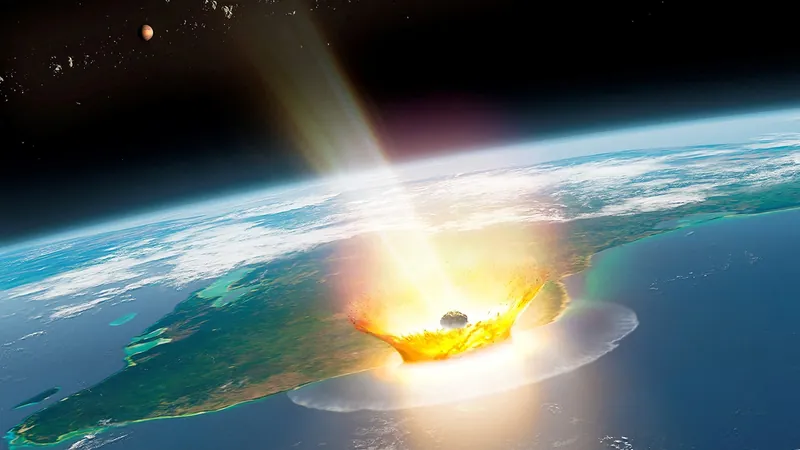
Revolutionary Nuclear X-Ray Method Could Deflect Asteroids and Save Earth from Catastrophe!
2024-09-24
Revolutionary Nuclear X-Ray Method Could Deflect Asteroids and Save Earth from Catastrophe!
In an astonishing breakthrough, scientists in Albuquerque, New Mexico, have unveiled a groundbreaking method to potentially divert dangerous asteroids threatening our planet. Their research indicates that by detonating a nuclear warhead more than a mile from the asteroid's surface and bombarding it with X-rays, these celestial objects could change course and avoid catastrophic collisions with Earth.
Traditionally depicted in Hollywood epics like "Armageddon" and "Deep Impact," past methods suggested blowing up an asteroid outright, which risks transforming it from a singular peril into a lethal spray of fragments hurtling towards Earth—a scenario experts want to avoid.
The urgency of planetary defense has never been more pronounced. Last year, the National Academy of Sciences classified asteroid threats as a national priority. Current estimates from NASA's ongoing sky surveys reveal that around 25,000 sizable cosmic objects, potentially capable of wreaking havoc upon impact, remain largely undetected, with only about one-third tracked adequately.
These invisible menaces, often masked by the sun's glare, traverse our solar system unnoticed. Notably, in 2013, a relatively minor asteroid caused devastation in Russia, while a more significant asteroid is believed to have contributed to the extinction of the dinosaurs. As Nathan Moore, a physicist at Sandia National Laboratories, points out, the reality of asteroid impacts is closer than many believe. “We don’t want to wait for a large asteroid to show up and scramble for the right method to deflect it,” he stated.
Moore and his team have leveraged Sandia's Z machine, the most potent pulsed-power device on Earth, to conduct experiments simulating an asteroid’s deflection. While these experiments are confined to Earth's gravity, the team ingeniously devised a technique dubbed "X-ray scissors." This innovative approach temporarily nullifies gravitational effects, enabling a more accurate simulation of asteroid behavior in the vacuum of space when subjected to intense explosive forces.
By suspending a miniature, silica-based model asteroid, weighing just a tenth of a gram, using ultra-thin foil, they managed to replicate conditions akin to those in outer space. Upon firing the Z machine, the foil vaporized instantly, freeing the "asteroid" to float unobstructed as X-ray bursts impacted its surface. This process is critical to ensuring that any deflection can be achieved without fragmenting the asteroid into multiple deadly pieces.
“Using the right amount of force to redirect the asteroid is the trick,” Moore explained, drawing comparisons to recent real-life asteroid interception missions like NASA’s DART experiment.
This exciting development comes at a timely moment, as NASA recently observed a "potentially hazardous" asteroid, designated 2024 ON, passing relatively close to Earth. This massive rock measures approximately 350 meters long and 180 meters wide—often referred to as “stadium-sized” and was recorded traveling at a distance of 621,000 miles from Earth. Although classified as potentially hazardous due to its size and proximity, there is currently no risk of impact. Such close encounters with asteroids of this magnitude typically occur every five to ten years.
With growing concerns over asteroid threats, this research could herald a new era in planetary defense. As scientists continue to refine methods to protect Earth, the quest to outsmart these giant cosmic bullets remains paramount. Stay tuned as humanity takes significant strides towards ensuring our planet’s safety from the celestial dangers looming above!


 Brasil (PT)
Brasil (PT)
 Canada (EN)
Canada (EN)
 Chile (ES)
Chile (ES)
 España (ES)
España (ES)
 France (FR)
France (FR)
 Hong Kong (EN)
Hong Kong (EN)
 Italia (IT)
Italia (IT)
 日本 (JA)
日本 (JA)
 Magyarország (HU)
Magyarország (HU)
 Norge (NO)
Norge (NO)
 Polska (PL)
Polska (PL)
 Schweiz (DE)
Schweiz (DE)
 Singapore (EN)
Singapore (EN)
 Sverige (SV)
Sverige (SV)
 Suomi (FI)
Suomi (FI)
 Türkiye (TR)
Türkiye (TR)